My 2022 Avery Research Trip to the United Kingdom by Terry Meinke
The following narrative was original written in the fall of 2022 and was published in the Thimble Collectors International Bulletin Fall 2022 issue.
__________________________________________________________________________________________________________________________________
After two years of Covid restrictions, I was finally able to travel to the United Kingdom to finish my research for a new book I am writing. The title of this book will be “Histories of the Birmingham Companies Associated with Avery Needle Cases.” The focus of the book will be to tell the history of each company from when it was established until it ceased to exist. It will also include information about the owners and photographs of the Avery needle cases they produced or sold.
Before my trip, I discovered there were eighteen companies in Birmingham related to Avery needle cases. Thirteen of these companies registered and manufactured fifty-five Avery-style needle case designs, most were stamped with other company names indicating they were made for others. Four other Birmingham businesses had their names stamped on needle cases that were registered by W. Avery & Son of Redditch. And lastly, William Avery of Redditch and his brother Joseph had a business in Birmingham for a few years during the late 1870s and early 1880s.
I started this research in 2017 when I spent three days in Birmingham, continued it in 2018 with five days there, and a year later in 2019 revisited the city for another three days. My original goal was to finish my research in 2020 but that trip was postponed because of the pandemic. Then in August 2022 after visiting with friends in the Redditch area where W. Avery & Son, the Victorian needle manufacturer who registered the most brass needle case designs, was originally from, I spent the next nine days in Birmingham. Now you are probably wondering why Birmingham. When most people see needle cases stamped with Avery’s name or one of the other needle manufacturers from the Redditch area, they assume these needle cases were made by those companies. But that is incorrect. After spending approximately twelve years researching Avery needle cases, I concluded that fancy brass needle cases were made by other companies in Birmingham. I also believe whenever someone comes up with an idea or theory, it is important to look for evidence to support it which is why I needed to do this research. Let me share with you a little about what I accomplished during my 2022 visit.
While in Redditch, I spent one entire day at the Forge Mill Needle Museum. This year all my time was spent with the Keeper of Collections, Jo-Ann Gloger, and her assistant Patrick Chester, also known as Chaz. And what were we doing? I was sharing my earlier research with them and asking for their opinions because of their in-depth knowledge of the needle manufacturing industry during the Victorian Period. Jo-Ann has been the lead person at the museum for over thirty years and Chaz has done significant local historical research. Both Jo-Ann and Chaz agreed with my theory that Avery-style needle cases were made in neighboring Birmingham, a major industrial city, only sixteen miles north of Redditch. Chaz added that he had personally reviewed hundreds of census records from 1841-1911 and found very few if any individuals with occupations related to the manufacture of small brass needle cases.
In the evening I enjoyed a wonderful dinner with Jo-Ann (Fig. 1) and her husband Richard at a restaurant in the area.
Also, while in Redditch, I spent time with Raymond McLaren, another researcher who is interested in the history of the fishing hook industry. During my visit with Raymond, we visited the grave of William Avery where I was able to sprinkle some of the ashes, I brought with me of my recently deceased dog who I named Avery in 2008. This way, my two favorite Averys could be together forever.
Later that day I had the opportunity to visit the Local History Museum which recently opened in Redditch and is managed by Pete Harris, another local historian. In addition to the Forge Mill Needle Museum, this is another museum I highly recommend people visit if they are in the Redditch area and want to learn more about what it was like during the Victorian Era. A day later, Ray, Pete, and I met at Ray’s house for a few hours and discussed my book as I wanted to get their opinions. I consider Jo-Ann, Chaz, Ray, and Pete my Redditch friends as I have visited with them before during earlier trips to the area.
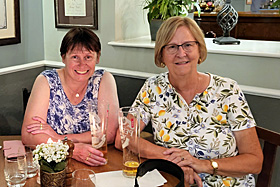
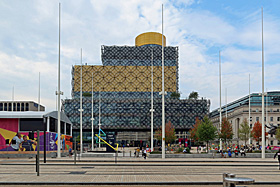
Left: Fig. 1 Jo-Ann and me at dinner. Right: Fig. 2. Birmingham Library.
My first stop in Birmingham was the Library of Birmingham (Fig. 2) which opened in 2013 to replace an earlier library and is known as the largest regional library in Europe. Before my trip, I made reservations with the Wolfson Centre for Archival Research to review records in their collection related to the eighteen companies I was researching. This section of the library has limited space and because the records are in storage, they must be ordered days in advance. I was able to determine the records I wanted to see by searching for the names of the companies and the owners on the library’s online website before my trip. During this and my previous visits to the library, I reviewed many records which included things like company histories, partnership agreements, birth, marriage, and death records, probate records, etc.
The most interesting things I found this year were: 1) a drawing of the Hirsch & Stern company building in the 1870s; 2) the citizenship/naturalization records related to one of the company’s directors; and 3) a newspaper article describing how one of the directors changed the spelling of his surname in 1916 during World War I because his ancestors were originally from Germany. Also, that day and the next I spent considerable time in the Heritage Research Area of the library where other records are available without having to be pre-ordered. Here I was able to locate many of the wills related to the owners of the companies I was researching. The most important area in this section was access to the Birmingham trade directories dating from the early 1800s through current times. These directories have trade or commercial sections listing the companies in alphabetic order and also by business type. These records prove the companies I’m researching were in trades that produced small metal objects, i.e., die sinkers, stampers, piercers, jewelers, etc.
One of my goals on this trip was to photograph the areas in the city where these companies were originally located. Most were in the city center or the Jewellery Quarter, walking distance from my hotel. Although many of the original Victorian Era buildings no longer exist, I felt it was important to see where they were originally and what was there now. While walking through the Jewellery Quarter, I discovered a building marked Deakin & Francis (Fig. 3), one of only two companies from the Victorian Era associated with Avery needle cases still in existence today. I rang the doorbell and one of the managers gave me a quick tour of their factory which had many of the same tools used during the Victorian Era (Fig. 4). In 2018 I spent three hours visiting the other company still doing business, W. O. Lewis Badges Ltd. These visits were very important because they allowed me to see how metal products, like badges and cuff links, were made today so I could compare them to how other metal items were made in the nineteenth century.
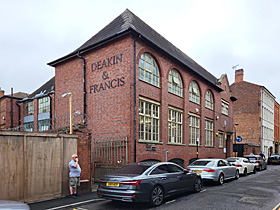
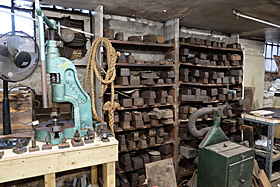
Left: Fig. 3 Deakin and Francis building exterior. Right: Fig. 4. Deakin and Francis interior.
In the Jewellery Quarter I also visited the J. W. Evans Silver Factory, a museum that provided a detailed tour demonstrating the Victorian methods for making metal items (Fig. 5). In earlier years I visited the Museum of the Jewellery Quarter, the Pen Museum and the Coffin Works Museum to get a better understanding of how metal objects were made in earlier times. My last stop in this area of Birmingham was the Key Hill Cemetery to photograph several of the graves of the people I was researching.
Near the center of Birmingham, I attended a tour of the Back to Backs National Trust Museum which shows how the working class lived during the nineteenth and early twentieth centuries. Although I had visited this museum once before in 2018, this visit was extra special. In late 2021 I was researching the London companies related to Avery needle cases for a future book when I met Richard Sherwin on Ancestry.com. He is a descendant of the London company Asser & Sherwin, a name stamped on four different Avery-style needle case designs. Richard moved to Birmingham years ago as his wife was from the area and he was now a tour guide at the Back to Backs Museum. He gave me a fabulous tour of the museum (Fig.6) and afterward we spent several hours together at lunch where I shared with him my Birmingham research to get his opinion and he shared his incredible knowledge of the working class in earlier times.
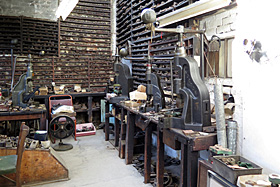
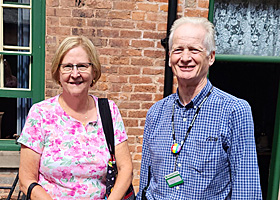
Left: Fig. 5. Interior of J. W. Evans silver factory. Right: Fig. 6. Dick and me at Back to Backs Museum.
Lastly, one of the most exciting parts of my trip occurred on my last full day in the Birmingham area. I decided to take a day trip to Nottingham to visit my friend Colin Jackson and his wife Liz. I met Colin online nine years ago as he was researching Copestake, Moore, Crampton & Co., a London company whose name appears on eleven different Avery needle case designs. When Colin and I first met in person in 2017 he agreed to be my agent in the UK. I call him my agent because the Copestake firm was either a licensee or agent of W. Avery & Son of Redditch. I think of Colin as Copestake and me as Avery. What this means is if I purchase an Avery needle case from someone in the UK who won’t ship it to the USA, I ask them to ship it to Colin instead. This way I can pick it up from him the next time I’m in the UK. This year Colin was holding three Avery needle cases for me of which two were extra special. Although I already had the Butterfly needle case stamped with Avery’s name, the one Colin was holding for me was stamped with the name Grands Magasins du Louvre - Paris (Fig. 7 & 8), a department store that opened in Paris in 1875. For me, it was very exciting to learn that the Butterfly design Avery registered in 1871 was also sold in France. This was the first time I ever saw an Avery needle case stamped with a French company name.
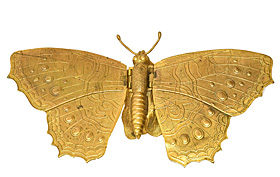
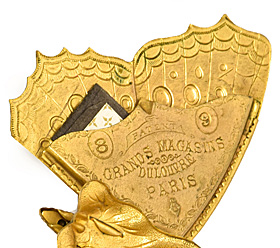
Left: Fig. 7. Avery butterfly needle case stamped with Grands Magasins name. Right: Fig. 8. Wing detail of Avery butterfly needle case stamped with Grands Magasins name.
The most exciting addition to my collection that Colin had for me was the Water Pump with Trough needle case (Fig. 9). This item was registered by the die sinker J. M. Farnol of 19 Hall Street in Birmingham in 1879 and this was the first time I or any of my other collector friends ever saw this design. It was an exact match to the design registration document but was missing the tiny handle. Colin, being an antique enthusiast who collects jewelry with his wife, purchased a tiny piece of brass from the Victorian Era and using the design registration photo as an example was able to recreate a replacement handle. What makes this item so special is that I know William Avery worked with Mr. Farnol on several occasions. Examples of Farnol’s 1879 design of the Donkey with Panniers have been found with either the W. Avery & Son Redditch name or no name stamped on it. Also, Avery registered the Lighthouse with Boat (Fig. 10) designed in 1878 and the Elephant with Howdah (Fig. 11) in 1880, and on both designs he used Farnol’s 19 Hall Street, Birmingham address as his own. These are the only needle case designs Avery registered at that address. This is further proof that Avery-style needle cases were made in Birmingham.
Although more and more historical records are becoming available online, on-site research is still invaluable. I’m looking forward to my 2023 trip to London to do research for my next book about the London companies.
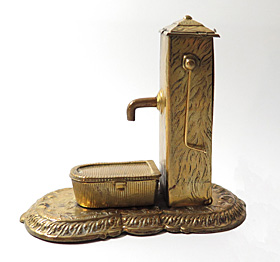
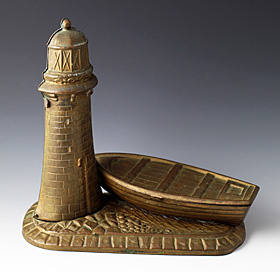
Left: Fig. 9. Water pump with trough needle case. Right: Fig. 10. Lighthouse with boat needle case.

Left: Fig.11. Elephant with howdah needle case.
Sources:
- Library of Birmingham. Wikipedia. https://en.wikipedia.org/wiki/Library_of_Birmingham.
- Le Louvre des Antiquaires. Wikipedia. https://en.wikipedia.org/wiki/Le_Louvre_des_Antiquaires.




